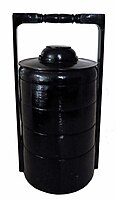User talk:Ayush1717
Tiffin carriers or dabbas are a kind of lunch box used widely in Asia for tiffin meals. From India they spread to Indonesia, Malaysia, and Singapore, where they are now widely used.
how they came about[edit]
When the British established themselves in India in the late 18th century, it soon became clear that adaptation was needed. For a start, the rituals of eating were going to have to change to accommodate the hot, languid days and nights. In the heat of the day lunch became a much lighter meal – but what to call it? Somehow, the word that seemed to stick was "tiffin", taken from the slang words "tiff", a tot of diluted liquor, and "tiffing", to take a sip of this liquor (perhaps a hint that a sahib's lunch might quite often be of the liquid variety!). Tiffin took off and "a spot of tiffin" soon became a peg on which almost any culinary indulgence between breakfast and dinner could be hung.
From these origins in British India tiffin has evolved to create a fascinating world of its own, a world that involves a whole range of dishes and equipment and above all of suppliers, from the tiffin wallahs of Bombay to the sellers of spiced tea and savoury snacks who cater for busy punters on the run. Today tiffin might mean a packed lunchbox or afternoon tea, a savoury snack or a sweet treat. As long as it is munched between breakfast and dinner, it is simply tiffin.
lunch in a box[edit]
The word tiffin is also used as a name for a lunchbox. Tiffins (or dhabbas) come in all shapes and sizes, but traditionally they are round, with three or four stacking stainless steel compartments firmly sealed with a tight-fitting lid and a side clip to avoid any nasty spillages and a handle for carrying on top.
In India food cooked at home with care and love is considered to deliver not only healthy (and relatively cheap) food but also divine contentment. Lunch is usually eaten thali-style, with a tantalising selection of regional delicacies that may include any combination of spicy vegetables, dhal, rice, yoghurt, pickles, bread and pudding served on a big steel plate or a banana leaf. The separate compartments in the tiffin lunchbox accommodate thali lunches perfectly.
Tiffin culture is now to be found all over India. Everyone – from women in brightly coloured saris working in the fields to giggling families on long train journeys – carries a tiffin to provide a compact, portable, homemade lunch.
Design and materials[edit]
Normally they come in two or three tiers, although more elaborate versions can have four. The bottom tier, sometimes larger than the others, is the one usually used for rice. Tiffin carriers are opened by unlocking a small catch on either side of the handle. Tiffin carriers are generally made out of steel and sometimes of aluminium, but enamel and plastic versions have been made by European companies.
-
Two dabbawalas in Mumbai delivering meals packed in tiffin carriers
-
Thai Tiffin box in Bangladesh.
-
Tiffin carrier, Burmese Lacquerware
different places where tiffin boxes are used[edit]
- people working in offices
- students in preschool
- students in school
- students in high school
- students in college
- army
- navy
See also[edit]
- Bento
- Lunch box
- Dabbawala
- Tiffin
- Tiffin Cup, a competition to find the best South Asian restaurant in the United Kingdom
- The Lunchbox (2013 Indian film)
references[edit]
- https://www.theguardian.com/lifeandstyle/2014/aug/17/tiffin-the-history-of-indias-lunch-in-a-box-mumbai
- https://en.wikipedia.org/wiki/Tiffin_carrier
Category:Food storage containers Category:Indian food preparation utensils Category:Serving and dining



